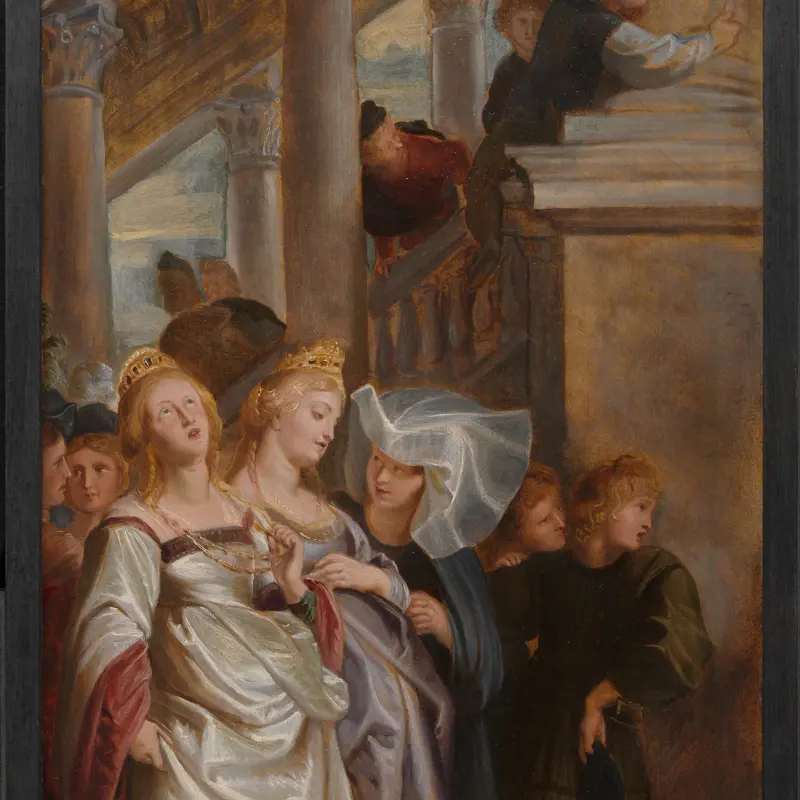Peter Paul Rubens, 'Kings Clothar and Dagobert dispute with a Herald', 1611-12
About the work
Overview
Rubens made this oil sketch, along with two others, in preparation for an altarpiece commissioned for St Bavo’s Cathedral, Ghent. The central panel depicts Saint Bavo, a Roman soldier who left the military for the Christian Church, being received as a monk. This scene, in which King Clothar and his son King Dagobert each sit astride a horse, appears on the right panel.
The two kings hold their arms out defiantly to block the advances of a herald of the Roman Emperor Mauritius. He thrusts a scroll towards them, which contains an edict from the Emperor forbidding his soldiers from becoming monks. In defiance of the edict, Clothar and Dagobert support Saint Bavo being received into the Church. Although the three main figures are surrounded by a crowd of people, it is the horses that dominate the composition, especially Dagobert’s silvery steed – its body covers the width of the painting.
Key facts
Details
- Full title
- Kings Clothar and Dagobert dispute with a Herald from the Emperor Mauritius
- Artist
- Peter Paul Rubens
- Artist dates
- 1577 - 1640
- Part of the group
- Oil Sketch for High Altarpiece, St Bavo, Ghent
- Date made
- 1611-12
- Medium and support
- Oil on wood (probably oak)
- Dimensions
- 107.6 × 41.1 cm
- Acquisition credit
- Holwell Carr Bequest, 1831
- Inventory number
- NG57.3
- Location
- Room 18
- Collection
- Main Collection
- Previous owners
- Frame
- 21st-century Replica Frame
Provenance
Additional information
Text extracted from the ‘Provenance’ section of the catalogue entry in Gregory Martin, ‘National Gallery Catalogues: The Flemish School: circa 1600–circa 1900’, London 1986; for further information, see the full catalogue entry.
Bibliography
-
1986Martin, Gregory, National Gallery Catalogues: The Flemish School, circa 1600 - circa 1900, London 1986
-
2001
C. Baker and T. Henry, The National Gallery: Complete Illustrated Catalogue, London 2001
About this record
If you know more about this work or have spotted an error, please contact us. Please note that exhibition histories are listed from 2009 onwards. Bibliographies may not be complete; more comprehensive information is available in the National Gallery Library.
Images
About the group: Oil Sketch for High Altarpiece, St Bavo, Ghent
Overview
These three oil sketches, or modelli, were made by Rubens in preparation for an altarpiece for St Bavo’s Cathedral, Ghent, which was commissioned by Bishop Maes around 1611. The central panel shows Saint Bavo, a Roman solider who left the military to join the Christian Church, standing on the steps of St Peter’s Church, Ghent. Having given away all his money, he is being received by Saints Amand and Floribert as a monk. The left panel shows Saint Bavo’s sisters, Gertrude and Begga, who followed their brother’s example by becoming nuns. On the right panel, King Clothar and his son King Dagobert argue with a herald of the Roman Emperor Mauritius about a rule that forbade soldiers from becoming monks.





























